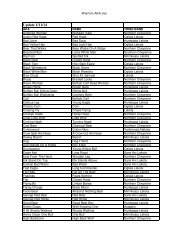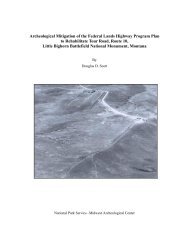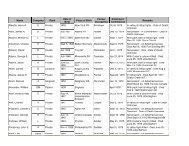New Sources on Arikara Scouts
New Sources on Arikara Scouts
New Sources on Arikara Scouts
- No tags were found...
Create successful ePaper yourself
Turn your PDF publications into a flip-book with our unique Google optimized e-Paper software.
This article draws up<strong>on</strong> these pensi<strong>on</strong> records and includes a number of interviews,most of which have not hitherto been published. These interviews yield interesting detailsabout <strong>Arikara</strong> scout service between 1865 and 1881, especially as they pertain to Custer’sbattle at the Little Bighorn.It must be noted that these interviews were c<strong>on</strong>ducted in 1911, 1923, and 1925, thusbetween thirty-five and forty-nine years after the Custer battle. C<strong>on</strong>sequently, the recordsc<strong>on</strong>tain some inaccuracies. N<strong>on</strong>etheless, they are of value to scholars interested in the PlainsIndian Wars, the Custer battle, and Native American scouts.ARIKARA MILITARY SERVICE, 1865-1881Before discussing the interviews, it is useful to provide some background informati<strong>on</strong> to<strong>Arikara</strong> military service and the reas<strong>on</strong>s they joined the U. S. Army in what could be called amilitary alliance against the Sioux. <strong>Arikara</strong> relati<strong>on</strong>s with the Lakota Sioux in particular (thesewere called Sanánat by the <strong>Arikara</strong>s) were complex. Periods of war were interrupted by tradingand even intermarriage. Still, by the mid-1800s, the <strong>Arikara</strong>s were surrounded by muchstr<strong>on</strong>ger Lakota tribes with whom they were regularly at war. If <strong>Arikara</strong> warfare in the 1700swas still characterized by territorial expansi<strong>on</strong> (at the expense of the Mandans and Hidatsas),by the 1800s they were <strong>on</strong> the defensive against the Lakotas. By this time, <strong>Arikara</strong> warriors(naahukoósu’) went to war for a number of reas<strong>on</strong>s: to defend their home territory againstinvaders, to protect their hunting grounds, to avenge the death of a relative by enemies, to endthe mourning period for a deceased loved <strong>on</strong>e, to gain prestige by accumulating war h<strong>on</strong>ors, toaccumulate wealth (horses and other plunder), to gain social status by giving away the spoils ofwar, to protect tribal trade interests, to capture women, to capture scalps for a specialsacrificial cerem<strong>on</strong>y, and to increase their prospects for marriage. Unfortunately, because oftheir small numbers and despite their bravery, the <strong>Arikara</strong>s tended to be at the mercy of theLakotas.1929 Elbowoods [White, page 1129 and 1274]; SOLDIER, SA-17797 ND 1 Mar 1921, srv 1868-81 Ind Scts USA, died7 May 1921 [White, page 1449]; STRIKES TWO, or TA TA REE WE CHI, wid Plum Woman, SA-17796 ND 1 Mar 1921,WC-10933 ND 7 Nov 1923, srv 1876 Ind Scts USA, died 8 Sep 1922 Elbowoods ND, I-O#1326420 [White, page1494]; YOUNG HAWK, wid Chief Lying Against, WC-10858 ND 2 Aug 1923, srv 1875-6 Ind Scts USA, died 16 Jan1915 Elbowoods ND [White, page 1724].2








